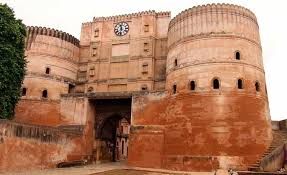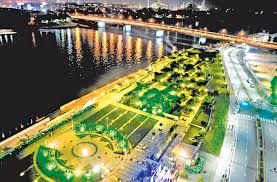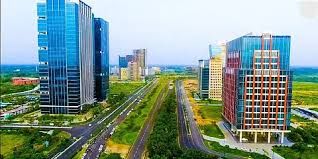Did you know, Why Ahmedabad became a hub for Trade and Commerce? Positioned in Gujarat and close to the Arabian Sea, the city has long been a crucial point for maritime trade. Founded in the 15th century by Sultan Ahmed Shah. Ahmedabad’s rise as a major trade and commerce hub is deeply rooted in its historical and strategic advantages. Founded in 1411, the city’s location along the Sabarmati River and its proximity to the Arabian Sea positioned it as a crucial trading centre. Its significance was further amplified during the British colonial era with the establishment of textile mills, which attracted investors and entrepreneurs, bolstering its economic standing.
Today, Ahmedabad is well-connected with modern roads, railways, and ports, which makes it easy for businesses to operate and move goods around. The city is known for being supportive of businesses, and it has important schools like the Indian Institute of Management Ahmedabad (IIMA) that teach people about business and management. Ahmedabad has also grown in other industries, such as medicines, chemicals, and technology. This mix of different types of businesses has made the city a key place for trade and commerce in India.
Origins and Development of Ahmedabad
| Foundation and Growth: Ahmedabad was founded in 1411 by Sultan Ahmed Shah, the ruler of the Gujarat Sultanate. The city’s foundation marked the beginning of a new chapter in Gujarat's history, with Ahmed Shah choosing the site for its strategic advantages. Located on the banks of the Sabarmati River, the city benefited from its position on key trade routes connecting the west coast of India to the interior. This advantageous location facilitated commercial growth and cultural exchange, contributing significantly to its development. |
|
Over the centuries, Ahmedabad evolved into a significant political and cultural centre. The city witnessed various rulers, including the Mughal Empire and the British colonial administration. Each period left its mark on the city, contributing to its rich cultural and architectural heritage.
Key Historical Landmarks
Sabarmati Ashram
Established by Mahatma Gandhi in 1917, the Sabarmati Ashram is a crucial site in India's struggle for independence. It served as Gandhi's residence and the headquarters for the Satyagraha movement, which promoted non-violent resistance against British rule. The ashram includes Gandhi’s former residence, a library, and a museum. Visitors can explore exhibits related to Gandhi’s life and the independence movement.
Jama Masjid
Built in 1424 by Sultan Ahmed Shah, this mosque stands as a testament to the architectural brilliance of the period. It was a central place of worship and a symbol of the city’s grandeur. The mosque is known for its impressive architecture, including a large prayer hall, intricately carved columns, and a beautiful courtyard. The blend of Hindu and Islamic architectural styles is particularly notable.
Sidi Saiyyed Mosque
Constructed in 1573, this mosque is renowned for its exquisite latticework, specifically the "Sidi Saiyyed Jali" or lattice screen. The latticework features intricate geometric and floral patterns, showcasing the skill of the craftsmen. The mosque’s design is a prime example of the architectural finesse of the period.
Bhadra Fort
|
|
Built by Sultan Ahmed Shah in 1411, Bhadra Fort served as a royal residence and military fortress. It was central to the city’s defence and administrative functions. The fort includes a grand entrance, a palace complex, and a series of defensive walls and gates. It also houses the Bhadra Kali Temple, adding a religious dimension to its historical significance. |
Hutheesing Jain Temple
Constructed in 1848, this temple is a prominent example of Jain architecture and is dedicated to the Jain Tirthankara Dharmanatha. The temple is known for its detailed carvings, elegant design, and serene atmosphere. It reflects the rich Jain heritage and architectural style, with intricately carved pillars and ceilings.
Rani Sipri's Mosque
Built-in 1514 by Rani Sipri, the wife of Sultan Mahmud Begada, this mosque is named after her and is notable for its distinctive architectural style. The mosque features a unique design with an open courtyard, ornate carvings, and a distinctive prayer hall. It represents the artistic and architectural preferences of the time.
Ahmedabad Railway Station
Serving as a key transportation hub, the Ahmedabad Railway Station is an important landmark reflecting the city’s growth and connectivity. The station’s architecture combines colonial and modern elements, accommodating the city's evolving needs while maintaining historical charm.
Festivals and Celebrations
Ahmedabad is celebrated for its vibrant festivals and rich cultural traditions. Major festivals like Navratri, Diwali, and Uttarayan are highlights of the city's cultural calendar. During Navratri, the city comes alive with traditional Garba and Dandiya Raas dances, drawing participants from all over. Diwali, the Festival of Lights, transforms Ahmedabad with its elaborate decorations and festive lights.
Uttarayan, or the Kite Festival, fills the skies with colourful kites and brings together families and friends for a joyous celebration. The city’s cultural heritage is deeply rooted in traditional arts such as Bandhani textiles and Kutch embroidery. Bandhani, or tie-dye, features vibrant patterns created through a meticulous process of tying and dyeing fabric. Kutch embroidery, known for its intricate needlework and mirrorwork, is another significant art form that showcases local craftsmanship. These traditional crafts are not only a testament to Ahmedabad’s rich heritage but also a crucial source of livelihood for many local artisans. Through these arts and festivals, Ahmedabad preserves and celebrates its cultural legacy.
Living in Ahmedabad
In terms of quality of life, Ahmedabad combines modern conveniences with traditional values. The city is equipped with excellent healthcare facilities, including both government hospitals and private clinics, ensuring access to comprehensive medical care. Educational opportunities are also plentiful, with notable institutions like the Indian Institute of Management Ahmedabad (IIMA) and the National Institute of Design (NID) contributing to the city’s reputation as an educational hub. Additionally, Ahmedabad offers a range of recreational activities, from parks and lakes to cultural centres and shopping areas. This blend of modern infrastructure, cultural richness, and accessible amenities makes Ahmedabad an appealing place to live for people seeking both comfort and cultural engagement.
Ahmedabad offers a variety of housing options to suit different preferences and budgets. For those seeking affordable living, neighbourhoods like Maninagar and Naroda provide budget-friendly choices. These areas offer basic amenities and good connectivity, making them suitable for families and individuals looking for cost-effective living arrangements. In contrast, for those who prefer a more upscale lifestyle, areas such as Satellite, Vastrapur, and Bodakdev are known for their high-end residences and luxurious apartments. These neighbourhoods feature well-developed infrastructure, and modern amenities, and are close to shopping centres, restaurants, and other key services, making them attractive to those looking for a higher standard of living.
Transportation and Connectivity in Ahmedabad
The Ahmedabad Municipal Transport Service (AMTS) operates an extensive network of buses covering various routes within the city and its suburbs. These buses are a popular choice for daily commutes due to their affordability and widespread coverage. The Bus Rapid Transit System (BRTS) in Ahmedabad provides a dedicated lane for buses, ensuring quicker and more efficient travel across key routes. BRTS buses are equipped with modern amenities and offer a comfortable ride.
Auto rickshaws are a common sight in Ahmedabad and offer a flexible and convenient mode of transport for short distances. They are a popular choice for navigating through the city's bustling streets. Taxis are available for hire and provide a more private and comfortable travel option. Ride-sharing services like Uber and Ola also operate in the city, offering additional convenience.
Connectivity
Ahmedabad is well-connected by various modes of transportation
Road: Ahmedabad is a major road hub with well-maintained highways linking it to other major cities in Gujarat and beyond. The city is connected to Mumbai via National Highway 48 (NH48) and to Delhi via National Highway 64 (NH64). The road network facilitates smooth travel and supports both commercial and personal transportation needs.
Rail: The Ahmedabad Junction (ADI) is a key railway station in the city, serving as a major junction on the Western Railway network. It connects Ahmedabad to major cities across India, including Mumbai, Delhi, and Jaipur. The station is well-equipped with amenities and handles a significant volume of passenger traffic daily.
Air: Sardar Vallabhbhai Patel International Airport (AMD) is the primary airport serving Ahmedabad. Located about 15 kilometres from the city centre, it offers domestic and international flights connecting Ahmedabad to major cities and global destinations. The airport is modern and well-equipped, providing a range of facilities for travellers.
Tourism and Attractions
Cultural Spots
To experience local culture, check out the Sidi Saiyyed Mosque, known for its exquisite stone carvings. The mosque’s windows have intricate designs that look like lace. Another popular spot is Kankaria Lake, a large lake surrounded by a park. Here, you can enjoy boat rides, visit an amusement park, or simply take in the scenic views.
Modern Attractions
|
|
Ahmedabad offers modern attractions too. The Sabarmati Riverfront is a great place to enjoy nature. It’s a park by the river where you can walk, relax, or even take a boat ride. For something unique, visit the Adalaj Stepwell. This old stepwell has steps leading down to the water and showcases ancient water storage methods with beautiful architecture. |
Museums and Art Galleries
If you like learning about the past, you should visit the Calico Museum of Textiles. This museum has a large collection of old fabrics and clothes, showing how people made and used textiles long ago. Another interesting place is the Ahmedabad Textile Museum, which also focuses on fabrics. It provides lots of examples of historical clothing and the art of fabric making.
Markets and Shopping
For shopping and food, visit Manek Chowk, a bustling market where you can taste delicious street food and buy local crafts. It’s especially lively in the evenings. Another great market is the Law Garden Night Market, known for its traditional clothes and accessories. It’s a fun place to find unique items and souvenirs.
Religious Sites
Ahmedabad also has beautiful religious sites. The Hathisingh Jain Temple is known for its detailed carvings and peaceful atmosphere, making it a serene place for prayer. The Swaminarayan Akshardham is a grand temple with impressive architecture and exhibits. It’s dedicated to the Swaminarayan faith and offers a rich cultural experience.
Economic Environment
Ahmedabad is a significant economic centre in the state of Gujarat, located in western India. The city has a diverse economic base, but it is particularly renowned for its thriving textile industry. This industry has been a cornerstone of Ahmedabad’s economy for many years, with numerous textile mills and factories contributing to the city’s economic growth. The textiles produced here range from traditional fabrics to modern garments, making Ahmedabad a key player in both domestic and international markets.
| In addition to textiles, Ahmedabad has developed several business parks and industrial areas that bolster its economic standing. One of the most important of these developments is the Gujarat International Finance Tec-City (GIFT City). This ambitious project is designed to be a global financial and technology hub, attracting multinational corporations and financial institutions. |
|
GIFT City features State-of-the-art infrastructure, including modern office spaces, residential areas, and recreational facilities. It aims to position Ahmedabad as a major player in the global financial and technology sectors, contributing significantly to the city's economic growth and development.
The presence of these business parks and industrial zones not only provides ample employment opportunities but also fosters innovation and investment, further driving Ahmedabad’s economic progress.
Educational Institutions
Ahmedabad is home to several prestigious educational institutions that enhance its reputation as a leading centre for education and research. The Indian Institute of Management Ahmedabad (IIMA) is one of the most esteemed business schools in India and globally. Established in 1961, IIMA offers a range of management programs, including its flagship Post Graduate Programme in Management (PGP). The institution is known for its rigorous academic standards, influential research, and strong connections with the business world. Its graduates are highly sought after by top companies, and the institute’s research and publications contribute to advancements in management and business practices.
Another prominent institution in Ahmedabad is the National Institute of Design (NID). Founded in 1961, NID is recognized for its exceptional design programs, which cover various fields such as industrial design, communication design, and fashion design. NID’s curriculum emphasizes creativity, innovation, and practical experience, preparing students to excel in the global design industry. The institute is known for its world-class faculty, state-of-the-art facilities, and strong industry connections, making it a leading centre for design education in India and beyond. In addition to these renowned institutions, SkillFloor has made significant strides in providing practical and accessible education for young professionals in Ahmedabad. SkillFloor offers specialized courses in areas like digital marketing, data science, and project management, focusing on hands-on learning and real-world applications.
Together, these educational institutions contribute significantly to Ahmedabad’s status as a hub of learning and innovation. They attract students from across the country and the world, fostering a vibrant intellectual community that drives research, creativity, and development.
Famous Ahmedabad meals
Ahmedabad’s culinary scene is a rich blend of traditional Gujarati flavours and vibrant street food culture. The city is celebrated for its iconic dishes such as Dhokla, Khandvi, and Fafda. Dhokla, a savoury steamed rice cake, is light and spongy, often garnished with mustard seeds and green chillies. Khandvi is a delicate roll made from gram flour and yoghurt, seasoned with spices and garnished with coconut. Fafda, a crispy snack, is deep-fried and seasoned with spices, making it a popular choice for breakfast or as a snack throughout the day.
These dishes are integral to Ahmedabad's food culture and are commonly enjoyed at street food stalls and local eateries. For a more immersive dining experience, you can explore renowned spots like Manek Chowk and Agashiye. Manek Chowk is a bustling food market that transforms in the evening, offering a variety of street foods including the city’s signature snacks. It provides a lively atmosphere where you can taste a range of traditional Gujarati foods. Agashiye, on the other hand, offers a more refined dining experience. Set in a heritage building, it specializes in traditional Gujarati thalis, which are elaborate platters of various dishes served together. This venue combines authentic flavours with a touch of elegance, making it a great choice for both casual dining and special occasions. These dining experiences not only showcase the depth of Ahmedabad’s culinary traditions but also highlight the city’s unique food culture.
Skillfloor’s Digital Marketing Course in Ahmedabad
Skillfloor offers a comprehensive Digital Marketing Course in Ahmedabad designed for beginners, students, and professionals aiming to build a strong career in the digital field. The course includes hands-on training in SEO, Google Ads, social media marketing, content marketing, and analytics. Learners work on real projects and receive globally recognized certifications. With expert mentorship, live campaign practice, and job placement assistance, Skillfloor ensures you gain the practical skills needed to succeed in today’s competitive market. Whether you're looking to upskill or start fresh, Skillfloor is the right place to begin your journey in digital marketing.
Contact: 07996969995
Address: Unit No: 1 to 5, 7th Floor, Manor Maxx, Commerce College Rd, near St. Xavier's College, Vasant Vihar, Navrangpura, Ahmedabad, Gujarat 380009
Map Location: https://maps.app.goo.gl/Y3Hh3R2yZgVZKtZ1A
Ahmedabad, founded in 1411 by Sultan Ahmed Shah, has evolved from a significant trading centre into a thriving modern city. Its historical importance is showcased through landmarks like the Sabarmati Ashram, where Mahatma Gandhi led the fight for independence, and the Jama Masjid, known for its stunning architecture. The city is also famous for its lively festivals and traditional crafts, which highlight its rich cultural heritage. Today, Ahmedabad is a major business hub, thanks to its well-connected transportation system and leading educational institutions like the Indian Institute of Management Ahmedabad (IIMA).
The city's blend of historical charm and modern development is evident in its bustling markets, diverse housing options, and unique culinary scene. From enjoying street foods to exploring new business opportunities, Ahmedabad offers a dynamic and vibrant environment that celebrates both its past and present.
Related Posts
Career Scope in MNC IT Companies in Ahmedabad
the exciting career scope in MNC IT companies in Ahmedabad. Explore job opportun...
How to Choose a Website Development Company in Ahmedabad
Learn how to choose the right website development company in Ahmedabad by consid...
Best Shopping Places In Ahmedabad
the best shopping places in Ahmedabad with our comprehensive guide. From bustlin...
























































